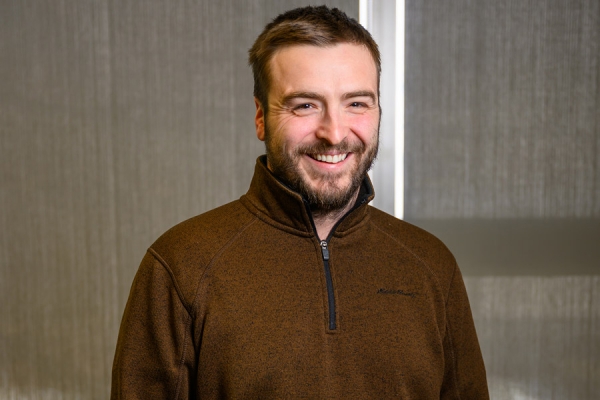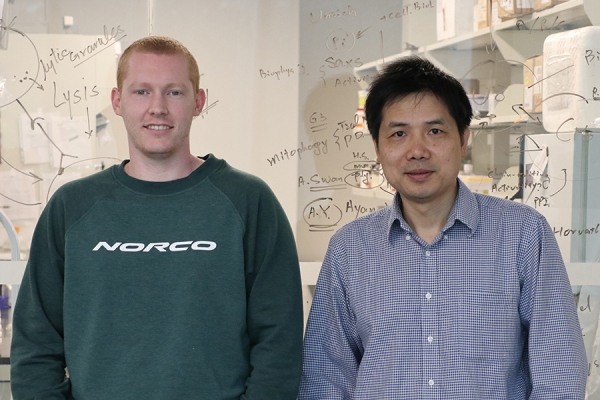Get the latest news in chemistry—new discoveries, trends, publications and updates that shape the field. Stay informed with quick and easy-to-read articles
A chance to work at a neutron scattering facility in Grenoble, France, helped advance his research, says biochemistry student Dominik Dziura.
Participants, judges, and organizers gather for a group photo at the University of Windsor's 2025 Three Minute Thesis (3MT) Competition, celebrating graduate research excellence and public speaking skills. r professor shines through at science gal
The second-place prize went to Piumi Kulatunga from the Rondeau-Gagne Group
Science Society vice-presidents Lindsey Boshart and Lauren Pandolfi flank teaching award winner Otis Vacratsis.
Student appreciation for professor shines through at science gala

Dean of science Claudio Verani (centre) congratulates twin sisters Jenny and Ally Noble on their second straight win of the Board of Governors In-Course Medal.
The “Women in Research 2025 Calendar” is available for purchase from the UWindsor chapter of Women in Chemistry.
Calendar highlights research achievements of women graduate students
Jonathan Houser and Liz Sylvestre are co-chairs of a symposium to showcase undergrad research at the 2025 conference of the Canadian Society for Chemistry.
Professors Mike McKay, Kenneth Ng, and Dan Mennill are leading an investigation into avian flu infections in local wild birds.
Researchers Ethan Douglas, Nick Vukotic, Anton Dmitrienko, and Joy-Lynn Kobti
PUBLICATION NEWS:
March 14, 2025
Underscoring the significance of the event, Prof. Drew Marquardt, President of CINS, shared: The Shaping the Future of Neutron Scattering in Canada workshop has been a critical event, uniting researchers, industry leaders, and policymakers to collaboratively define a technical path forward for neutron scattering in our nation. The insights discussed here are instrumental as Canada advances towards establishing a new research reactor, ensuring Canada remains at the forefront of scientific innovation. These are important conversations to have with the Canadian neutron scattering community, and we truly appreciate CNL involving CINS in this process.
November 21, 2024- Marquardt’s leadership was sought by the National Institute for Standards and Technology (NIST; U.S. Department of Commerce) to assist the NIST Center for Neutron Research in leading a design and planning for a new high-capacity scattering source (research reactor). Marquardt served as the chair of "Transition Process" panel where he wrote a report will be compiled into a report to the U.S. Congress that will shape the plan for a new neutron source and accompanying facilities. Title: Neutrons For The Future Page 162, Chapter 12 Chair: Drew Marquardt Panel Members: Stuart Castillo, Ronald Rogge, Jamie Schulz
Abstract
Human Remains Detection (HRD) dogs are specifically trained to aid law enforcement agencies in search operations for deceased victims. Their olfactory sensitivity and specificity highlight the importance of choosing target odor sources for HRD training. While HRD dogs rely on olfactory cues to locate human remains, it is important to identify which volatile organic compounds (VOCs) they are alerting to among those released during the various stages of the human decomposition process. In this study, VOC profiles from human and non-human bones were collected and analyzed using thermal desorption coupled to comprehensive two-dimensional gas chromatography time-of-flight mass spectrometry (TD-GC × GC-TOFMS). The non-human decomposition VOC profiles were compared to human VOC profiles obtained from sections of amputated human limbs used as HRD training aids. These limb sections were previously decomposed to the dry remains/skeletonization stage. The olfactory responses of HRD dogs in the presence of these training aids and non-human remains were subsequently investigated with results demonstrating their capability in distinguishing human from non-human remains. Highlighting the differences in VOC profiles between human and non-human decomposition may help to enhance the sensitivity of HRD dogs to human remains while recognizing the importance of using human cadaveric material for training purposes.
Abstract
The detection of skeletal remains using human remain detection dogs (HRD) is often reported anecdotally by handlers to be a challenge. Limited studies have been conducted to determine the volatile organic compounds (VOCs) emitted from bones, particularly when there is limited organic matter remaining. This study aimed to determine the VOCs emitted from dry, weathered bones and examine the detection performance of HRD dogs on these bones when used as training aids. The VOCs of four different bones (clavicle, rib, humerus, and vertebrae) from three cadavers were collected using sorbent tubes and analyzed using comprehensive two-dimensional gas chromatography‒time-of-flight mass spectrometry (GC × GC‒TOFMS). Subsequently, the responses of the HRD dogs to the bone samples were recorded over two separate two-day trials. A total of 296 VOCs were detected and classified into chemical classes, with aromatics and linear aliphatics being the most abundant classes. Several differences in the chemical class distribution were observed between the bone types, but the number and intensity of the VOCs were similar between the bone samples. During the HRD dog training, a higher false detection rate was observed on the first day of each trial; however, the detection rate improved to 100 % on the second day of each trial. Although the dogs are capable of detecting bones, they require exposure to and training with a diverse range of skeletal remains to enhance their efficiency. This is necessary due to the variations in the types and intensity of VOCs compared to earlier decomposition stages involving soft tissue.
Identifying VOCs from human remains detectable in water using comprehensive two-dimensional gas chromatography













